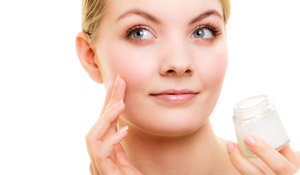
Acne, warts, fine lines and wrinkles, and dry, sensitive skin are irritating (in more ways than one), but these skin problems donít always require a trip to the doctor. Board-certified dermatologist Craig Kraffert, MD, of Californiaís ReddingDerm Clinical & Aesthetic Dermatology practice, highlights the most effective topical treatments for each of these common skin conditions and how to use them to their best advantage.
Problem: Acne
Best Solution: Benzoyl peroxide in a cleansing bar, lotion, cream, or gel.
How it Works: Benzoyl peroxide is an oxidant (a substance that produces oxygen), and helps fight acne by reducing the amount of bacteria on the skin. Benzoyl peroxide also has exfoliant properties that remove dead skin cells and help to keep pores open to prevent acne formation. It works best for mild to moderate acne and may take up to six weeks before you see improvement.
Professional Advice: "You must reapply benzoyl peroxide daily in order for the medication to continue to kill skin bacteria," Kraffert notes. "Start slowly, and use only as directed (no more, no less) for effective treatment without skin irritation. You can try benzoyl peroxide on a small area first to make sure you have no reaction with the strength you are using." Thatís because "Allergic and hypersensitivity reactions to benzoyl peroxide occur in up to 3% of users and are frequently moderate to severeóso new users should be aware of this risk and discontinue if rash develops," Kraffert says.
In addition, "Benzoyl peroxide can also be very drying, so moisturizers may be more necessary. Finally, benzoyl peroxide is very prone to causing inadvertent bleaching of fabrics, including shirts, blouses and towels. Use caution with cloth textiles around this productóeven once it has been absorbed and the skin surface is dry."
Problem: Warts
Best Solution: Salicylic acid.
How it Works: Apply liquid drops of salicylic acid-based treatment directly on a wart as directed for approximately 7 to 10 days. Layers of affected skin will peel off until the wart is completely dissolved. Amounts of salicylic acid in wart removal products vary; for instance a liquid treatment might contain 17% salicylic acid, while a wart removal patch might contain 40%.
Professional Advice: "For common warts located on the fingers, hands, elbows, or knees, salicylic acid has withstood the test of time and is still among the best options on the market," says Kraffert. "But be sure to use the product as directed, for the amount of time indicated; donít try to speed up the process or you can literally get burned." Kraffert also points out that many common warts disappear on their own within a couple of years, though this might not be an option if youíre impatient. For warts on your face, around fingernail beds, on the soles of your feet, or in the genital area, see your physician for appropriate treatment.
But be warned: "High concentrations of salicylic acid as found in wart products can be extremely irritating," Kraffert adds. "Because of this, even proper use of these products must be done with great care. Irritation of the wart and underlying skin is part of what makes this treatment effective. Accordingly, the application of these products should be focused on the precise area where the wart surface resides."
Problem: Dry (Sensitive) Skin
Best Solution: Lactic or glycolic acid (alpha-hydroxy acid, or AHA) creams and lotions, and fragrance-free emollients (products that soften the skin) made with minimal ingredients.
How it Works: Lactic and glycolic acid-based products remove dead skin cells while emollients soften and moisturize the skin.
Professional Advice: "Apply dry skin solutions immediately after you come out of a shower or bath and towel-dry," Kraffert recommends. "The idea is for the cream to hold the water in your skin to moisturize while also lifting off dead skin cells." Note that patients with certain skin conditions should be careful: "These products help very dry skin but can make dry skin eczema worse. They should be applied with caution or not at all to skin with eczema or dry skin dermatitis," Kraffert cautions.
Problem: Fine Lines and Wrinkles (Sun Damage)
Best Solution: Creams and lotions that contain retinol (a form of vitamin A) work on a cellular level to improve skin texture, diminish fine lines, plump up wrinkles and fade discolorations.
How it Works: Apply as directed. Initially, you may experience some irritation and dryness until your skin builds up tolerance, but over-the-counter brands are usually less irritating than prescription creams because of differences in the form of the vitamin A used as well as the other ingredients with which it is mixed. After anywhere from two to six months, you should begin to see age spots disappearing, improved skin tone, fewer lines, and softer wrinkles.
Professional Advice: "Quality varies in over-the-counter products, and price can be an issue," Kraffert warns. "Choose well-known and respected brands." Furthermore, "Retinol can increase sun sensitivity, so sunscreen should be part of regimens containing retinolóas it should be for all a.m. skin care regimens," he notes.
Craig Kraffert, MD, reviewed this article.
Sources
Craig Kraffert, MD. E-mail messages to author. November 30, 2014.
Kwok CS, Gibbs S, Bennett C, Holland R, Abbott R. "Topical Treatments for Curaneous Warts." The Cochrane Database of Systematic Reviews 2012 12(9):CD001781. Doi: 10.1002/14651858.CD001781.pub3.
Tucker-Samaras S., T. Zedayko, C. Cole, et al. "A Stabilized 0.1% Retinol Facial Moisturizer Improves the Appearance of Photodamaged Skin in an Eight-Week, Double-Blind, Vehicle-Controlled Study." Journal of Drugs in Dermatology 2009 8(10):932-6.
"Guidance for Industry: Topical Acne Drug Products for Over-the-Counter Human UseóRevision of Labeling and Classification of Benzoyl Peroxide as Safe and Effective. Small Entity Compliance Guide." US Department of Health and Human Services Food and Drug Administration Center for Drug Evaluation and Research. June 2011.
"Salicylic Acid 40% Adhesive Patch." Kaiser Permanente. Information last revised March 2013. Selected from National Drug Data File.





